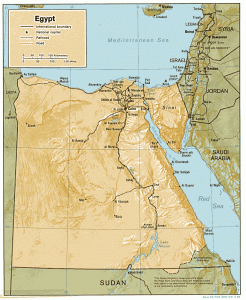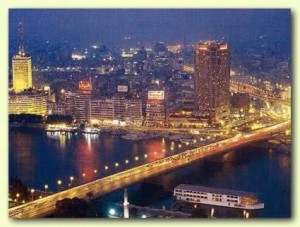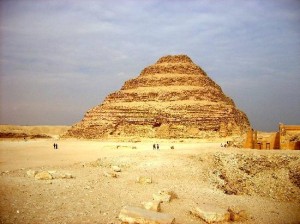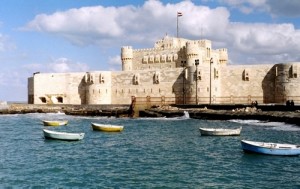This article is written by Manoj Radhakrishnan, an engineer and a travel photographer & writer based in Pune
There are not many countries in the world which present greater tourist attractions than Egypt and certainly not many with a longer history. Attractions in Egypt are so well known that the response to “I am off to Egypt” is always a “When?” and never a “Why?”. Not surprisingly, for the first time in three attempts, it wasn’t hard for me to convince a couple of my friends – Aravind and Kartik – to join me for a trip overseas. And my long cherished dream of visiting Egypt finally came true when I landed in Cairo late one sultry summer evening.
Travelling in Egypt, like travelling in any new region, had its share of idiosyncrasies. Adjusting to strange numerals in the automobile license plates to ceiling fans which ran faster at lower regulator settings was challenging enough, but the hardest thing to cope with was the security. It ranged from being forced to register your passport within the first week to walking through x-ray machines every time one entered a hotel, bank or a shop selling chewing gums. But the high point was definitely the intercity convoy – which is a bunch of tourist vehicles flanked by army trucks with each tourist vehicle having a pair of Kalashnikova carrying policemen. As if this wasn’t enough, the convoy always chooses to leave at the strangest early morning hours. The funniest part is that the convoy invariably falls apart within metres of leaving the city and the policemen always try to outdo each other in emulating Rip Van Winkle. Luckily, the convoy does not exist off the beaten track, that is if you can put Sinai and Alexandria in that category. Despite these minor glitches, the overall security in the country is enough to protect you from everything except perhaps the obstinate shop keepers who refuse to believe that one may not be interested in buying spices at three in the morning.
Given the security, it was no surprise to learn that Egypt is extremely safe to travel around. But it was definitely surprising to hear that the tourism wasn’t affected by the events of 11th Sep. The only thing that seems to keep the tourists away is the heat. Summer in Egypt is a constant 40 C + which, thanks to the hot winds, seems twice that in the Sahara. Even our group strength was only nine (four during the last week) – it is normally about twice as big. Some of us were badly affected by the heat and almost all of us were dehydrated at least once during our stay. On the bright side, enduring that heat offered us a chance to photograph the country’s monuments without having 200 clueless tourist staring randomly in the foreground. Luckily for me, I came back without doing much damage to my body. Although I am tempted to attribute it to my strong build and rugged lifestyle, the real reason for my good health is just dumb luck.
Egypt has enough history to leave anyone dazed. It is easy to feel intimidated by so many names and information hurled at you everyday. Although doing a bit of research before the trip helps, we quickly realised that our best defence was to hire a guide at every spot, be it a temple, tomb or a museum. Even in the following pages, I have tried my best to separate the historical information about the sites – all of which are accessible via hyperrlinks – from the general travel journal.
It is not possible for me to end this section without mentioning a strange torture me and my two friends were subjected to during our trip, we being singled out purely due to our country of birth. Everyone we met, passed by, ignored, saw, didn’t notice, was adamant in addressing us as Amitabh Bacchan, an Indian film star of the ’80s. How they could figure out our nationality is still beyond my comprehension and by the end of the trip, I was pretty much reduced to referring to my passport to remember my own name!
A night view of Cairo
We spent three days in Al Kahira (otherwise known as Cairo) which was just about enough to give us a taste of what the city has to offer. The first of those three days was spent at the two of the biggest attractions of the city viz., the Giza pyramids and the Egyptian museum. Over the centuries the pyramids seem to have become the symbol of not only the country, but of history itself. The impact of the first sight of them was pretty breathtaking to say the least. The pyramid of Kufu (Cheops), the tallest of the three Giza pyramids, is the only surviving member of the seven ancient wonders of the world and at a height of 140m, it also remained as the tallest structure in the world for over forty centuries.
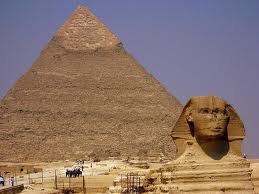 The sphinx and the pyramid of Khafre (Chephren)
The sphinx and the pyramid of Khafre (Chephren)
Our time at the site was spent going into the pyramid of Khafre (Chephren) – which involved crawling through a long dark narrow passage half the human height – looking at the 4500 year old solar boat of Kufu (currently preserved in a temperature and dust controlled museum) and driving to the nearest plateau point to get the view of all the three pyramids in one shot. And of course, no trip to the region is complete without gaping at the sphinx and visiting the valley temple of Chephren and the nearby Papyrus institute – all of which were duly completed before lunch. The Egyptian museum is so huge that it would take about an year to view all the exhibits. But a good guide can show you the highlights and probably teach you quite a bit of Egyptian history in less than two hours. We had a great guide, Sahar, and I probably learnt more from her in that afternoon than my month long self study prior to the trip. The highlight of the museum was definitely the Tutankhamun’s section and the mummy room. The gold collection of Tutankhamun makes one wonder how much a pharaoh like Ramesis the great could have carried to his grave when the least important boy king took west Africa’s budget deficit with him. The mummy room, on the other hand, presents you with an unique opportunity to look at Egypt’s greatest rulers centuries after they breathed their last.
We had our next free day in Cairo after we returned from Sinai to complete the first leg of our three week tour. That day the three of us along with Melody, Jane and David took a trip to Saqqara and Memphis and braved the scorching heat to visit the oldest stone structure in the world – the step pyramid of Djozer. Built in 27 century BC by Imhoptep, the step pyramid is still in a very good condition. Saqqara complex also houses many other tombs, most of which are always closed for renovation or excavation. The ones which were open included the funerary complex of Djozer, the pyramid of Teti with its famous pyramid text, and the 32 room funerary complex of his vizier, Mereruka. Memphis, the capital of the first dynasty (c. 3200 BC), contrastingly, has nothing to offer except a small museum housing a fallen statue of Ramesis II. This day was also the day when we bid farewell to half our group and the rest (the three of us and Melody) continued on to Siwa and Alexandria.
